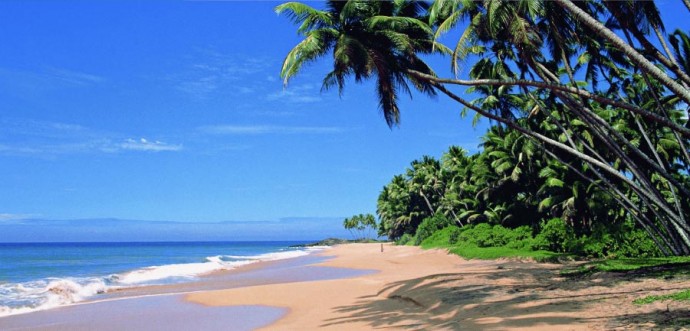
By Rosanna Crawley
Why Goa?
Goa is no longer the hippy retreat of a few years back, although there are still party places (mainly from Mapusa up the coast to Maharashtra). These days you can choose between cheap packages, boutique hotels or the quieter reaches of southern Goa.
Once you’ve chosen your accommodation, you can make the most of the beautiful beach. The region as a whole is distinct from much of India, with a Portuguese heritage, Catholicism still strong, and a people of gentle humour and civility. Beaches, forts, palm groves, coves, paddy fields and more are the attractions. November to March is the best time to visit.
Traditional Village House – Vivenda Dos Palhacos
Location: In the village of Majorda, half an hour’s drive south of Goa airport in the open-sided Jeep of Simon Hayward (half of the brother-sister English expat owner team) and just 10 minutes’ stroll from a long stretch of welcoming and pristine beach.
Character: A traditional Goan Portuguese hacienda built in 1929, with a relaxed house party atmosphere that is chic without being self-concious. The swimming pool in particular is deliciously inviting.
Rooms: 14 rooms in all, each individually designed, spacious and with en suite bathrooms. Beautiful, vivid local furnishings make for a jewel-like ambience. Among the “rooms” you can opt for a self-contained cottage or a vast tent.
Food: You eat whatever Charlotte finds fresh in the market that day. If you like what you taste (and it’s invariably very good), learn how to cook some of the local dishes by taking the odd lesson from Jibby, the Keralan chef, in the huge and well-equipped kitchen.
We like: Sharing a table for a full breakfast spread, excellent early evening gins and tonic and after-supper table-top dancing with the other guests, who, during our stay, included a fascinating contemporary artist from Wales, a sophisticated couple down from Mumbai and another, relaxed young couple with two angelically-behaved children.
Not so keen: It’s hard to avoid the pedlars on the beach, a problem endemic to certain parts of the region. And if the idea of sharing tables to dine doesn’t appeal, then this is not the place for you.
Essentials: 0091 832 322 1119; www.vivendagoa.com. From £49 for a double room (£27 in monsoon), including continental breakfast.
Colonial Era Fortress – Hotle Tiracol Fort Heritage
Location: A good four hours’ hair-raising drive north of the airport, by which time you’ll have learnt the Goan Highway Code, an elaborate language of beeps that warns fellow road users retrospectively of a driver’s intention to overtake, undertake or simply drive straight at oncoming traffic. A final five-minute four-car ferry takes you across the River Tiracol, above which the fort rises sedately from its promontory.
Character: A beautifully restored 16th-century colonial Portuguese fort.
Rooms: Four deluxe suites and six double rooms, some with private terraces and balconies. Stylishly furnished, bright yellow ochre fabrics and walls mirror the mellow glow of evening sun and provide a warm contrast to the clutter-free, dark-tiled wet rooms.
Food: The perfect place to unwind in stylish comfort -even the dining arrangement removes any need for decision-making as a set dinner of numerous Goan specialities is included in your room price. Better still, you dine looking out across the water.
We like: The breeze is a godsend across the roof terrace dining area, where temperatures can top 95F.
Not so keen: As this is a heritage hotel, there’s no swimming pool, though it’s an easy 15-minute walk down to the beach.
Essentials: 0091 222 404 2211. Standard double £78, suites £103, including continental breakfast and Goan dinner. Book through India Beat (www.indiabeat.co.uk).
Easy living on the beach – Ciaran’s Camp
Location: Well located in the centre of Palolem Beach – widely considered one of Goa’s most idyllic spots.
Character: Clean, tidy and upmarket beach huts that are popular among posh gap-year students, burnt-out media executives and the usual proliferation of long-limbed, blonde beauties that tropical silver sands seem to attract.
Rooms: Bamboo beach huts facing either directly on to the Arabian Sea or into a neatly manicured but rather out-of-place lawn with the kind of “keep off” signs usually reserved for heritage gardens back home. Each hut offers mosquito nets, fans, electricity and en suite shower rooms.
Food: The restaurant is one of the best in Palolem, offering daily fresh seafood barbecues. It’s also right next to one of the area’s livelier bars, a place that offers every kind of furniture on which to lie back and relax – from bean bags to hammocks and swinging chairs.
We like: The simplicity of beach-hut living but with the home comforts of flushing loos and hot showers.
Not so keen: Given the charm and easy-going nature of the surroundings, it’s odd that the management of the place seems anything but laid-back and customer-friendly.
Essentials: 0091 832 264 3477; www.ciarans.com. Rates from £24 per hut per night.
Getting there
For personalised tours to Goa and the rest of India, contact India Beat (00 91 141 651 9797; www.indiabeat.co.uk). An excellent specialist operator, it is run from Rajasthan by expat Indiaphiles Victoria Mills and Bertie Dyer, who, after several years building personal relationships, offer individually tailored tours based on first-hand experience of the places they recommend.
The pair can work with a variety of budgets, but expect to spend upwards of £1,000 per person on a trip (including flights) that incorporates a few nights at each of the destinations reviewed.
